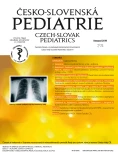Viscoelastic method rotational thromboelastometry (ROTEM)
Authors:
M. Durila
Authors‘ workplace:
Klinika anesteziologie, resuscitace a intenzivní medicíny 2. LF UK a FN Motol, Praha
Published in:
Čes-slov Pediat 2019; 74 (7): 430-435.
Category:
Review
Overview
Viscoelastic method rotational thromboelastometry (ROTEM) is incorporated in European and Czecho-slovak guidelines for management of heavy bleeding. The justification for this method is that it enables a rapid diagnosis of coagulopathy at the patient's bed and in certain situations alternates the commonly used PT/APTT plasma tests.
For a better understanding of the principle of this test, the author describes the physiology of a new model of cellular haemostasis that promotes the investigation of clotting in the whole blood. The article also provides practical information for evaluation of ROTEM results and an overview of medical fields where this method is currently being successfully used. In general, the use of the ROTEM method allows aimed treatment of coagulopathy, resulting in the reduction in bleeding intensity and a significant reduction in transfusion of blood products, especially fresh frozen plasma.
Keywords:
coagulopathy – bleeding – thromboelastometry
Sources
1. Hoffman M, Monroe DM. A cell-based model of hemostasis. Thromb Haemost 2001; 85 (6): 958–965.
2. Zaoral T, Blatný J, Vobruba V, et al. Česko-Slovenský mezioborový doporučený postup: diagnostika a léčba život ohrožujícího krvácení (ŽOK) u dětských pacientů v intenzivní a perioperační péči. Čes-slov Pediat 2018; 73 (1): 57–61.
3. Rossaint R, Bouillon B, Cerny V, et al. The European guideline on management of major bleeding and coagulopathy following trauma: fourth edition. Crit Care 2016; 12 (20): 100.
4. Kozek-Langenecker SA, Afshari A, Albaladejo P, et al. Management of severe perioperative bleeding: guidelines from the European Society of Anaesthesiology. Eur J Anaesthesiol 2013; 30 (6): 270–382.
5. Oswald E, Stalzer B, Heitz E, et al. Thromboelastometry (ROTEM) in children: age-related reference ranges and correlations with standard coagulation tests. Br J Anaesth 2010; 105 (6): 827–835.
6. Deng Q, Hao F, Wang Y, et al. Rotation thromboelastometry (ROTEM) enables improved outcomes in the pediatric trauma population. J Int Med Res 2018; Sep 10 : 10 : 300060518794092.
7. Sujka J, Gonzalez KW, Curiel KL, et al. The impact of thromboelastography on resuscitation in pediatric liver transplantation. Pediatr Transplant 2018; 22 (4): e13176.
8. Vida VL, Spiezia L, Bortolussi G, et al. The coagulative profile of cyanotic children undergoing cardiac surgery: The role of whole blood preoperative thromboelastometry on postoperative transfusion requirement. Artif Organs 2016; 40 (7): 698–705.
9. Sangkhathat S, Suwannarat D, Boonpipattanapong T, et al. Rotational thromboelastometry in the diagnosis of coagulopathy in major pediatric surgicaloperations. J Pediatr Surg 2015; 50 (11): 2001–2004.
10. Faraoni D, Emani S, Halpin E, et al. Relationship between transfusion of blood products and the incidence of thrombotic complications in neonates and infants undergoing cardiac surgery. J Cardiothorac Vasc Anesth 2017; 31 (6): 1943–1948.
11. Anil H, Kilic Yildirim G, Harmanci K, et al. Thromboelastogram as a tool to predict hypercoagulability in children with cystic fibrosis. Clin Appl Thromb Hemost 2018; 24 : 348–352.
12. Özdemir ZC, Düzenli Kar Y, Gündüz E, et al. Evaluation of hypercoagulability with rotational thromboelastometry in children with iron deficiency anemia. Hematology 2018; 23 (9): 664–668.
13. Kawada PS, Bruce A, Massicotte P, et al. Coagulopathy in children with liver disease. J Pediatr Gastroenterol Nutr 2017; 65 (6): 603–607.
14. Durila M, Beroušek J, Vymazal T. Rutinné používanie tromboelastometrie (ROTEM) k hodnoteniu koagulácie (adopcia ,,novej“ paradigmy hodnotenia koagulácie) na jednotke intenzívnej starostlivosti vedie k značnému zníženiu podávania krvnej plazmy. Transfuze Hematol dnes 2016; 22 (3): 168–171.
15. Vymazal T, Astraverkhava M, Durila M. Rotational thromboelastometry helps to reduce blood product consumption in critically ill patients during small surgical procedures at the intensive care unit – a retrospective clinical analysis and literature search. Transfus Med Hemother 2018; 45 (6): 385–387.
16. Durila M, Jonas J, Durilova M, et al. Thromboelastometry as an alternative method for coagulation assessment in pediatric patients undergoing invasive procedures: A pilot study. Eur J Pediatr Surg 2018; Aug 1. doi: 10.1055/s-0038-1667111.
17. Gorlinger K, Saner FH. Prophylactic plasma and platelet transfusion in the critically ill patient: just useless and expensive or even harmful? BMC
Labels
Neonatology Paediatrics General practitioner for children and adolescentsArticle was published in
Czech-Slovak Pediatrics

2019 Issue 7
- What Effect Can Be Expected from Limosilactobacillus reuteri in Mucositis and Peri-Implantitis?
- The Importance of Limosilactobacillus reuteri in Administration to Diabetics with Gingivitis
Most read in this issue
- Cystic fibrosis newborn screening and CFSPID diagnostics
- Viscoelastic method rotational thromboelastometry (ROTEM)
- Historie cystické fibrózy u nás – editorial
- Allergic bronchopulmonary aspergillosis in pediatric patients with cystic fibrosis
